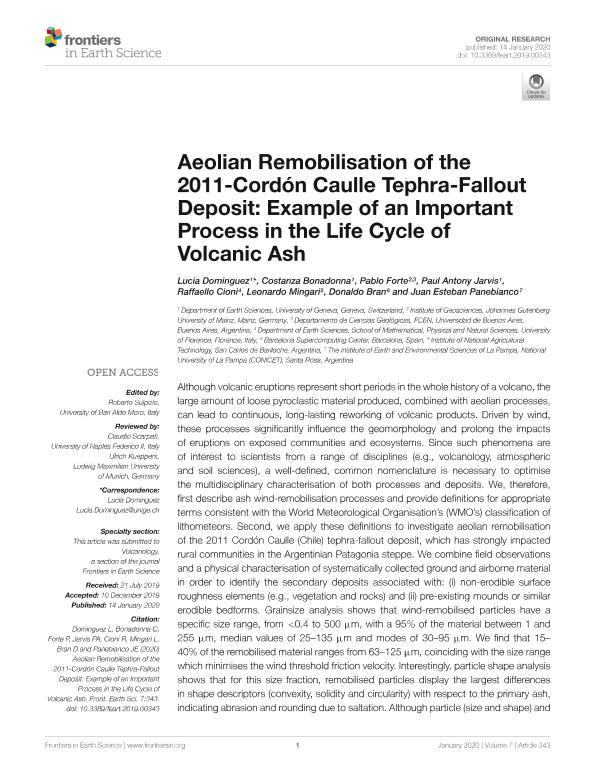Mostrar el registro sencillo del ítem
dc.contributor.author
Dominguez, Lucia
dc.contributor.author
Bonadonna, Costanza

dc.contributor.author
Forte, Pablo Brian

dc.contributor.author
Jarvis, Paul Antony
dc.contributor.author
Cioni, Raffaello
dc.contributor.author
Mingari, Leonardo Alejandro

dc.contributor.author
Bran, Donaldo Mauricio

dc.contributor.author
Panebianco, Juan Esteban

dc.date.available
2023-01-05T18:00:23Z
dc.date.issued
2020-01
dc.identifier.citation
Dominguez, Lucia; Bonadonna, Costanza; Forte, Pablo Brian; Jarvis, Paul Antony; Cioni, Raffaello; et al.; Aeolian Remobilisation of the 2011-Cordón Caulle Tephra-Fallout Deposit: Example of an Important Process in the Life Cycle of Volcanic Ash; Frontiers Media; Frontiers in Earth Science; 7; 1-2020; 1-20
dc.identifier.issn
2296-6463
dc.identifier.uri
http://hdl.handle.net/11336/183586
dc.description.abstract
Although volcanic eruptions represent short periods in the whole history of a volcano, the large amount of loose pyroclastic material produced, combined with aeolian processes, can lead to continuous, long-lasting reworking of volcanic products. Driven by wind, these processes significantly influence the geomorphology and prolong the impacts of eruptions on exposed communities and ecosystems. Since such phenomena are of interest to scientists from a range of disciplines (e.g., volcanology, atmospheric and soil sciences), a well-defined, common nomenclature is necessary to optimise the multidisciplinary characterisation of both processes and deposits. We, therefore, first describe ash wind-remobilisation processes and provide definitions for appropriate terms consistent with the World Meteorological Organisation’s (WMO’s) classification of lithometeors. Second, we apply these definitions to investigate aeolian remobilisation of the 2011 Cordón Caulle (Chile) tephra-fallout deposit, which has strongly impacted rural communities in the Argentinian Patagonia steppe. We combine field observations and a physical characterisation of systematically collected ground and airborne material in order to identify the secondary deposits associated with: (i) non-erodible surface roughness elements (e.g., vegetation and rocks) and (ii) pre-existing mounds or similar erodible bedforms. Grainsize analysis shows that wind-remobilised particles have a specific size range, from <0.4 to 500 μm, with a 95% of the material between 1 and 255 μm, median values of 25–135 μm and modes of 30–95 μm. We find that 15–40% of the remobilised material ranges from 63–125 μm, coinciding with the size range which minimises the wind threshold friction velocity. Interestingly, particle shape analysis shows that for this size fraction, remobilised particles display the largest differences in shape descriptors (convexity, solidity and circularity) with respect to the primary ash, indicating abrasion and rounding due to saltation. Although particle (size and shape) and deposit features (morphology and structures) alone are insufficient to interpret transport mechanisms, their combination suggests that whilst saltation is the most common particle transport mechanism, suspension and creep also play an important role. As well as inferring transport mechanisms from this combined approach, we also demonstrate how the correlation of the primary volcanic source with the associated remobilised deposits is fundamental to our understanding of the life cycle of volcanic ash.
dc.format
application/pdf
dc.language.iso
eng
dc.publisher
Frontiers Media

dc.rights
info:eu-repo/semantics/openAccess
dc.rights.uri
https://creativecommons.org/licenses/by-nc-sa/2.5/ar/
dc.subject
LITHOMETEOR CLASSIFICATION
dc.subject
TEPHRA FALLOUT
dc.subject
TRANSPORT AND DEPOSITION PROCESSES
dc.subject
VOLCANIC ASH LIFE CYCLE
dc.subject
WIND REMOBILISATION
dc.subject.classification
Vulcanología

dc.subject.classification
Ciencias de la Tierra y relacionadas con el Medio Ambiente

dc.subject.classification
CIENCIAS NATURALES Y EXACTAS

dc.title
Aeolian Remobilisation of the 2011-Cordón Caulle Tephra-Fallout Deposit: Example of an Important Process in the Life Cycle of Volcanic Ash
dc.type
info:eu-repo/semantics/article
dc.type
info:ar-repo/semantics/artículo
dc.type
info:eu-repo/semantics/publishedVersion
dc.date.updated
2021-09-06T20:27:34Z
dc.journal.volume
7
dc.journal.pagination
1-20
dc.journal.pais
Suiza

dc.description.fil
Fil: Dominguez, Lucia. Universidad de Genova; España
dc.description.fil
Fil: Bonadonna, Costanza. Universidad de Genova; España
dc.description.fil
Fil: Forte, Pablo Brian. Johannes Gutenberg Universitat Mainz; Alemania. Universidad de Buenos Aires. Facultad de Ciencias Exactas y Naturales. Departamento de Geología; Argentina. Consejo Nacional de Investigaciones Científicas y Técnicas; Argentina
dc.description.fil
Fil: Jarvis, Paul Antony. Universidad de Genova; España
dc.description.fil
Fil: Cioni, Raffaello. Università degli Studi di Firenze; Italia
dc.description.fil
Fil: Mingari, Leonardo Alejandro. Consejo Nacional de Investigaciones Científicas y Técnicas; Argentina
dc.description.fil
Fil: Bran, Donaldo Mauricio. Consejo Nacional de Investigaciones Científicas y Técnicas; Argentina
dc.description.fil
Fil: Panebianco, Juan Esteban. Consejo Nacional de Investigaciones Científicas y Técnicas. Instituto de Ciencias de la Tierra y Ambientales de La Pampa. Universidad Nacional de La Pampa. Facultad de Ciencias Exactas y Naturales. Instituto de Ciencias de la Tierra y Ambientales de La Pampa; Argentina
dc.journal.title
Frontiers in Earth Science
dc.relation.alternativeid
info:eu-repo/semantics/altIdentifier/url/https://www.frontiersin.org/article/10.3389/feart.2019.00343/full
dc.relation.alternativeid
info:eu-repo/semantics/altIdentifier/doi/http://dx.doi.org/10.3389/feart.2019.00343
Archivos asociados
